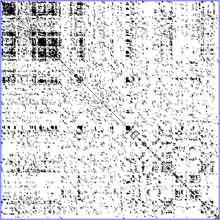Dot plot

A dot plot is a graphic method of bioinformatics to compare two biological sequences with each other (or a sequence with itself). The sequences are plotted on the horizontal and vertical axes (top and left) and matches between a row and column are marked by a dot at the corresponding intersection.
The dot plot is used to find similar or matching regions. This representation was first published by Gibbs and McIntyre in 1970 and has been developed since then. Although almost 50 years old, dot plots are still used in current publications such as B. in the analysis of epigenetic control in plants.
interpretation
In the picture on the right, a DNA sequence has been compared with itself. In addition to the expected, complete correspondence of the sequence, recognizable by the diagonal (top left to bottom right), there are further regional similarities.
An interruption of the diagonals with a continuation shifted downwards or to the right would reveal insertions (e.g. introns ) or deletions (not the case here). Lines outside the main diagonal stand for similar or repetitive units.
See also
Programs for generating dot plots
- ANACON - contact analysis of dot plots.
- Dotlet - program for dotplot generation.
- dotmatcher - part of the EMBOSS suite, web form for generating dotplots.
- Dotplot - small HTML5 tool for teaching dotplots of RNA sequences.
- dotplot - R Package for traditional or ggplot dotplots.
- Dotter - Interactive standalone tool for generating dot plots in Linux.
- JDotter - Java version of Dotter.
- Flexidot - Python-based, feature-rich dotplot suite for generating dotplots.
- Gepard - Interactive dotplot tool for generating dotplots for comparing entire genomes
- Genomdiff - Java dotplot program for viral genomes.
- GenY - web application in which dot plots can be generated.
- lastz and laj - programs for the visualization of genome alignments.
- seqinr - R package for dot plot generation.
- SynMap - web-based tool to generate dot plots for many genomes. The CoGe genomics platform provides access to an extensive database.
- UGENE Dot Plot viewer ( Memento from April 16, 2016 in the Internet Archive ) - Dotplot open source software.
- Basic article on dot plots with references and example algorithms for generation (in English) , as well as stand-alone software for generating small and medium-sized dot plots.
Individual evidence
- ^ Adrian J. Gibbs, George A. Mcintyre: The Diagram, a Method for Comparing Sequences. Its Use with Amino Acid and Nucleotide Sequences . In: European Journal of Biochemistry . tape 16 , no. 1 , September 1970, ISSN 0014-2956 , pp. 1–11 , doi : 10.1111 / j.1432-1033.1970.tb01046.x .
- ↑ Aoi Hosaka, Raku Saito, Kazuya Takashima, Taku Sasaki, Yu Fu: Evolution of sequence-specific anti-silencing systems in Arabidopsis . In: Nature Communications . tape 8 , no. December 1 , 2017, ISSN 2041-1723 , doi : 10.1038 / s41467-017-02150-7 , PMID 29255196 , PMC 5735166 (free full text) - ( nature.com [accessed May 13, 2018]).
- ^ Peter Rice, Ian Longden, Alan Bleasby: EMBOSS: The European Molecular Biology Open Software Suite . In: Trends in Genetics . tape 16 , no. 6 , June 2000, ISSN 0168-9525 , p. 276–277 , doi : 10.1016 / s0168-9525 (00) 02024-2 ( elsevier.com [accessed May 13, 2018]).
- ↑ Erik LL Sonnhammer, Richard Durbin: A dot-matrix program with dynamic threshold control suited for genomic DNA and protein sequence analysis . In: Genes . tape 167 , no. 1-2 , December 1995, ISSN 0378-1119 , pp. GC1 – GC10 , doi : 10.1016 / 0378-1119 (95) 00714-8 ( elsevier.com [accessed May 13, 2018]).
- ↑ Ryan Brodie, Rachel L. Roper, Chris Upton: JDotter: a Java interface to multiple dotplots generated by dotter . In: Bioinformatics . tape 20 , no. 2 , January 22, 2004, ISSN 1367-4803 , p. 279–281 , doi : 10.1093 / bioinformatics / btg406 ( oup.com [accessed May 13, 2018]).
- ↑ Kathrin M. Seibt, Thomas Schmidt, Tony Heitkam: FlexiDot: Highly customizable, ambiguity-aware dotplots for visual sequence analyzes . In: Bioinformatics . doi : 10.1093 / bioinformatics / bty395 ( oup.com [accessed May 14, 2018]).
- ^ Jan Krumsiek, Roland Arnold, Thomas Rattei: Gepard: a rapid and sensitive tool for creating dotplots on genome scale . In: Bioinformatics . tape 23 , no. 8 , April 15, 2007, ISSN 1367-4803 , p. 1026-1028 , doi : 10.1093 / bioinformatics / btm039 ( oup.com [accessed May 13, 2018]).